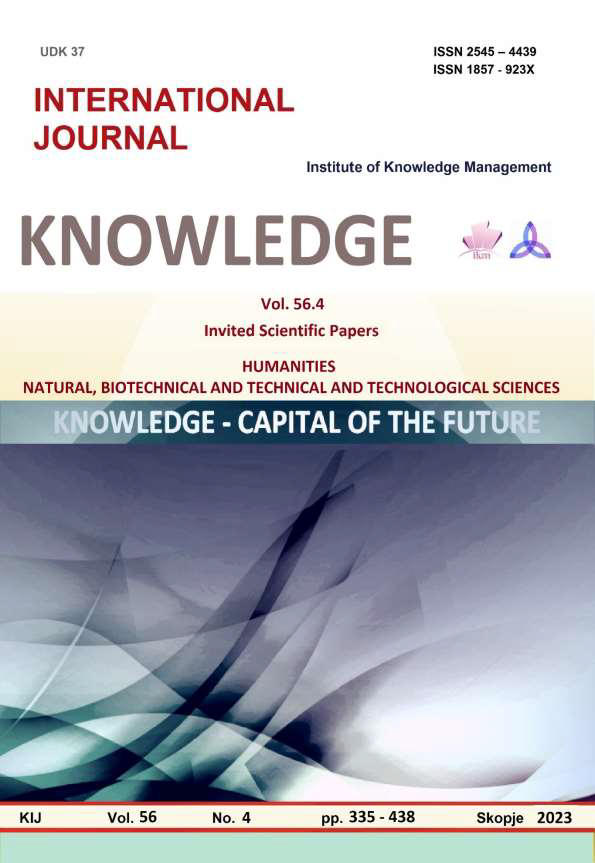INFLUENCE OF THE RAW-MATERIAL COMPOSITION AND THE CHARACTERISTICS OF THE KNITTED FABRICS ON THE PROPERTIES OF THE SOCKS
Keywords:
socks, yarn, knitted fabric, raw material compositionAbstract
Socks are a basic need of human and also very important factor for human health. Socks are knitted
fabrics that are made on single and double cylinder hosiery machine. There are many types of socks, and the most
common division according to purpose is women's, men's, children's, sports socks and tights. The raw material
composition of socks depends on their purpose. Short socks are one of the few clothing textiles that are made from
at least three different raw materials, cotton, polyamide and elastane. Polyamide textured multifilament yarn and
elastane are added to increase the elasticity of the socks. Depending on the purpose, wool or other fibers can be used
instead of cotton. Thermophysiological comfort of socks is very important parameter for usage performance of
socks. This significance even increased when we underwent a work of low or high activity. It causes the sweating of
our body with different rates. The structure, the characteristics of the knitted fabrics as well as the raw material
composition of the yarn significantly affect the technological production process and ultimately the quality of the
socks. Socks are not just simple accessories in everyday clothing, but represent modern and unique pieces of
clothing that constantly follow all fashion trends. In this paper, a brief overview of the types of socks, as well as the
international marking of the sizes of shoes and socks, was made. In addition, an analysis of the scientific research
was made to assess the influence of the raw material and the characteristics of the knitted fabrics on the properties
and quality of the socks. The results show that the socks are dimensionally unstable and after several washing cycles
during use there are changes in the dimensions that depend on the raw material composition and the type of yarn as
well as the characteristics of the knitted fabric. Socks made of cotton and polyamide yarn (PA6) should be washed at
a lower temperature to avoid the large changes in the transverse and longitudinal dimensions of the socks.
References
Bush, N. (2012). Folk socks, The history&Handknitted footwear. Loveland: Interweave Press, 2012.
Gligorijević, V. (2013). Tehnologija pletenja II deo,. Leskovac: Tehnološki fakultet.
Mansoor, V., Hes, L., Bajzik, V., & Skenderi, Z. (2018). Effect of moisture content on thermophysiological properties of terry knitted socks followed by thermal resistance comparison among different skin models. Fibre Society Conference. Davis, California.
Meral, Ž. (2017). Ispitivanje uporabnih svojstava muških kratkih čarapa. Zagreb: Sveučilište u Zagrebu, Tekstilno-tehnološki fakultet.
Petrović, V.M. (2000). Tehnologija pletenja. Zrenjanin: Tehnički fakultet 'Mihajlo Pupin'.
Šarac T., Trajković D., Ćirković N., & Savić, M. (2011). Uticaj sirovine i strukturnih karakteristika pletenina na kvalitet čaraparskih proizvoda. Zbornik radova Tehnološkog fakulteta, (стр. 244-251). Leskovac.
Senthilkumar, P., & Suganthi, T. (2019). Influence of tuck stitch in wale direction on thermal comfort characteristics of layered knitted fabrics. Indian J. Fibre Text. Res., 44, 65–74.
Shoe size chart. (2022). Retrieved from: https://images.search.yahoo.com/search/images?p=shoe+size+chart&fr=yfp-t-s&imgurl=https%3A%2F%2Fwww.activityshelter.com%2Fwp-content%2Fuploads%2F2016%2F06%2Fmens-shoe-size-chart-cricket.jpg#id=37&iurl=https%3A%2F%2Fimage.winudf.c
Stygienė, L., Krauledas, S., Abraitienė, A., Varnaitė Zuravliova, Z., & Dubinskaitė, K. (2022). Thermal Comfort and Electrostatic Properties of Socks Containing Fibers with Bio-Ceramic, Silver and Carbon Additives. Materials, 15(8).
Vasanth Kumar, D., & Raja, D. (2021). Study of Thermal Comfort Properties on Socks made from Recycled Polyester/Virgin Cotton and its Blends. Fibers and Polymers, 22, 841-846.
Vrljičak, Z., & Pavlović, Ž. (2014). Dimenzijska nestabilnost kratkih čarapa. Tekstil, 63 (1-2), 27-40.
Vrljičak, Z., & Kovač, A. (2011). Projektiranje i izrada kratkih čarapa. Tekstil,, 60(4), 149-159.





